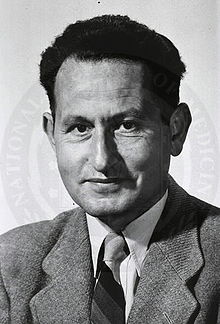Heinz Fraenkel-Conrat
This article includes a list of references, related reading or external links, but its sources remain unclear because it lacks inline citations. (February 2013) |
Heinz Fraenkel-Conrat | |
|---|---|
 Heinz Fraenkel-Conrat | |
| Born | July 29, 1910 |
| Died | April 10, 1999 (aged 88) Oakland, California, U.S. |
| Nationality | Germany |
| Citizenship | United States |
| Alma mater | University of Breslau, University of Edinburgh |
| Known for | Tobacco Mosaic Virus |
| Awards | Lasker Award (1958) |
| Scientific career | |
| Fields | Biochemist |
Heinz Ludwig Fraenkel-Conrat (July 29, 1910 – April 10, 1999) was a biochemist, famous for his research on viruses.
Early life[]
Fraenkel-Conrat was born in Breslau/Germany.
He was the son of Lili Conrat and Professor Ludwig Fraenkel, director of the Women's Clinic of the University of Breslau, Germany. His father, Ludwig Fraenkel, was a prominent gynecologist and medical researcher who published regarding endocrine function, social gynecology, and sexology during the first decades of the 20th century, and was one of the legion of scientists summarily dismissed from their positions by the Nazis.
Academic career[]
He received an MD from the University of Breslau in 1933. Due to the rise of Nazism in Germany he left for Scotland in 1933 and finished his PhD at the University of Edinburgh (1936). After completing his doctorate, he emigrated to the United States, becoming a naturalized citizen in 1941. In the 1940s Fraenkel-Conrat visited his sister and brother-in-law, biochemist Karl Slotta, a pioneer in the study of progesterone, estriol, and medical use of venom, who was then director of the Chemical Institute of the Instituto Butantan in São Paulo, Brazil, from 1935 to 1948. Frankel-Conrat remained for one year of biochemical research at the Instituto Butantan. He worked at a number of institutes before joining the faculty at the University of California, Berkeley in 1952 where he remained until his death.
His most noted research was on the tobacco mosaic virus (TMV) and the holmes ribgrass virus (HRV). He discovered that the genetic control of viral reproduction was RNA and that it is carried in the nucleic core of each virus. In 1955 he and biophysicist Robley Williams showed that a functional virus could be created out of purified RNA and a protein coat. In 1960 he announced the complete sequencing of the 158 amino acids in the virus.
Death[]
He died of lung failure on April 10, 1999 at the Kaiser Hospital in Oakland, at the age of eighty-eight.
References[]
- Asimov, Issac (1965). The New Intelligent Man's Guide to Science. New York: Basic Books, Inc. pp. 613–614. LCCN 65-23045.
- Fraenkel-Conrat, H (1994), "Early days of protein chemistry", FASEB J. (published Apr 1, 1994), 8 (6), pp. 452–453, doi:10.1096/fasebj.8.6.8168696, PMID 8168696, S2CID 9137540
- Rovery, M; Desnuelle, P (1954), "Application comparée de la technique de Sanger et de la technique d'Edman-Fraenkel Conrat à la détermination des résidus N-terminaux des protéines (Comparative application of the Sanger technique and the Edman-Fraenkel-Conrat technique in the determination of the N-terminal residues of proteins)", Bulletin de la Société de Chimie biologique, 36 (1), pp. 95–108, PMID 13160741
- American virologists
- 1910 births
- 1999 deaths
- American biochemists
- German emigrants to the United States
- Recipients of the Albert Lasker Award for Basic Medical Research
- Alumni of the University of Edinburgh
- Members of the United States National Academy of Sciences
- American biochemist stubs